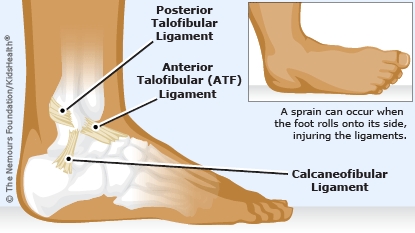Ankle Sprain: How to Care for Your Child
A sprained ankle is a common injury, especially in teens. While a sprain can be quite painful, it is not a permanent injury and kids can learn ways to help prevent future sprains.


The ankle joint is made of bones and ligaments (strong bands of tissue that hold the bones together). An ankle sprain occurs when the ankle is twisted or bent and a ligament is stretched or torn.
A sprain can take days or weeks to heal, depending on the injury. Your child's ankle will probably need support while it is healing. Your health care provider might use an elastic bandage, a splint, or a boot, depending on how involved the injury is.

First 48 hours:
-
Think RICE
-
Rest: Don't allow your child to put weight on the ankle.
-
Ice: Apply cold packs or compresses to the ankle for 10–15 minutes every 3–4 hours. Place a towel between the ice and the skin.
-
Compression: If the health care provider recommended it, have your child wear an elastic bandage for at least 2 days to minimize swelling.
-
Elevation: To reduce swelling, raise the ankle above heart level by resting it on a pillow.
-
Do NOT apply heat in any form to the ankle for at least 24 hours. Heat will increase swelling and pain.
-
Give your child ibuprofen for pain if your health care provider says it's OK (or give acetaminophen, if your health care provider prefers).
After 48 hours:
-
Your child should not put weight on the ankle until the health care provider says it's OK.
-
If your child was given crutches, make sure he or she uses them safely, and does not use them on stairs unless shown how to do so properly.
-
If given a boot or splint for support, your child should wear it as directed.
Follow the health care provider's instructions about your child's return to sports and activities. Once able to participate again, it's best to gradually increase activity as the pain allows.


-
The pain is not relieved by the recommended medications.
-
The swelling doesn't go down within 1–2 weeks of the injury.
-
Your child sprains the same ankle again or feels pain for more than 4 weeks.

-
The foot or toes become numb, pale, or blue.
-
Your child shows signs of infection, such as fever, or a red or hot ankle.